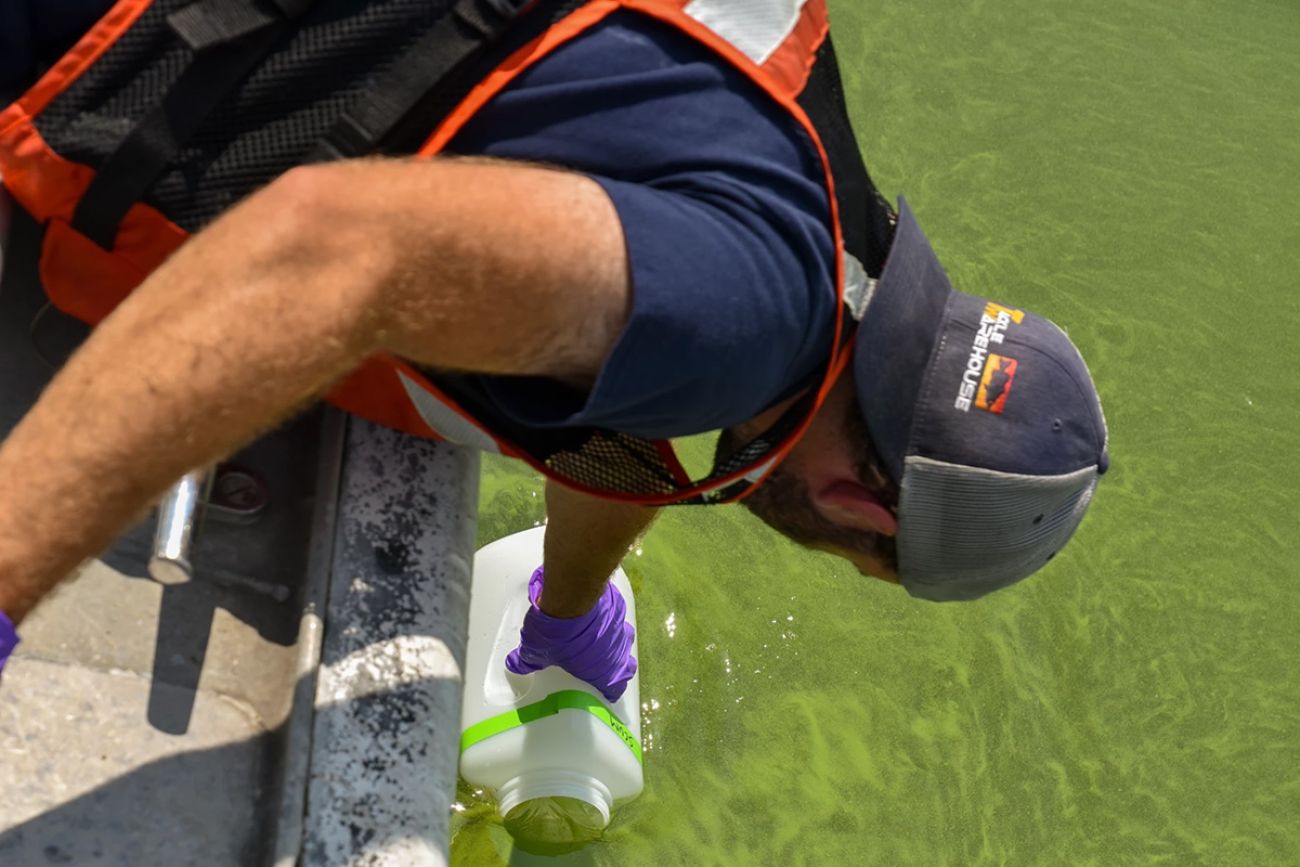Lawsuit accuses EPA of failing to prevent harmful algal blooms in Lake Erie

- Toledo and Lucas County say the EPA has failed to prevent harmful algal blooms in western Lake Erie
- They say the agency doesn’t measure the amount of phosphorus from confined animal feeding operations, or CAFOs, and other sources
- Agricultural waste from Michigan has contributed to toxic green algae in the lake
Lucas County in Ohio, the city of Toledo, and the Environmental Law and Policy Center are suing the U.S. Environmental Protection Agency over harmful algal blooms in western Lake Erie.
The lawsuit alleges that the EPA's consent order with the state of Ohio does not measure the actual amount of phosphorus from sources like manure that's getting into the Maumee River and the western basin of Lake Erie, primarily from unregulated large-scale animal feeding operations called CAFOs.
This article is part of The Great Lakes News Collaborative, which includes Bridge Michigan, Circle of Blue, Great Lakes Now at Detroit Public Television, and Michigan Radio. It unites newsroom resources to report on the most pressing threats to the Great Lakes and drinking water supplies, including pollution, climate change, and aging infrastructure. The independent journalism is supported by the Charles Stewart Mott Foundation.
Phosphorus is a mineral that encourages the growth of cyanobacteria, commonly called harmful algal blooms.
Related:
- Michigan farm czar: Our fight against Lake Erie pollution isn't working
- Supreme Court poop dispute could have big impact on Michigan environment
- Too few farmers are curbing pollution in Lake Erie. Should they be forced?
Lucas County Commissioner Pete Gerken said Ohio, unlike many other states, does not require CAFOs to have permits to limit the amount of manure they produce, and how they dispose of it. He said that encourages more and more CAFOs to set up operations in the state.
"We know that the majority of the pollution from the Maumee River, Lake Erie now is coming from concentrated feeding operations. There's large concentrations of cattle upstream that are taking their effluent, taking their waste, putting it on farm fields and it's running directly in," he said.
Gerken added that the city of Toledo had to take steps to control its municipal sewage from flowing into Lake Erie.
"We found a way with technologies to control our waste being discharged into the river," he said. "There are technologies they [CAFOs] can use other than just spreading it on a field. Citizens have paid to treat their waste — corporations don't want to."
Michigan efforts
Manure runoff from CAFOs and cropland in Michigan has contributed to toxic green algae in Lake Erie. In 2015, Michigan signed an agreement with Ohio and Ontario to reduce the amount of phosphorus spilling into the lake by 40% by 2025, but in a December interview with Bridge Michigan, Tim Boring, director of the Department of Agriculture and Rural Development acknowledged the state will not meet its deadline.
Like Ohio, Michigan has declined to force farmers to limit their pollution, instead relying on taxpayer-funded, voluntary programs that pay farmers to change their ways. It does not appear to be working.
Michigan does regulate CAFO waste, but state officials argue those regulations are too weak. When the state moved to strengthen them, farm groups sued.
In April, MDARD announced a nearly $5 million grant to the Alliance for the Great Lakes to increase water-quality monitoring in five subwatersheds of the western Lake Erie basin. “The information gleaned from this effort will help MDARD better understand various drivers of nutrient transport and allow for better targeting of conservation efforts to combat nutrient pollution,” the department said in a news release.
The EPA said it's reviewing the lawsuit. The agency added that addressing the problem of algal blooms in the western basin of Lake Erie will take time and "unflagging commitment and resolve" from everyone.
Bridge Michigan’s Kelly House contributed to this report.
Michigan Environment Watch
Michigan Environment Watch examines how public policy, industry, and other factors interact with the state’s trove of natural resources.
- See full coverage
- Subscribe
- Share tips and questions with Bridge environment reporter Kelly House
Michigan Environment Watch is made possible by generous financial support from:
Our generous Environment Watch underwriters encourage Bridge Michigan readers to also support civic journalism by becoming Bridge members. Please consider joining today.
See what new members are saying about why they donated to Bridge Michigan:
- “In order for this information to be accurate and unbiased it must be underwritten by its readers, not by special interests.” - Larry S.
- “Not many other media sources report on the topics Bridge does.” - Susan B.
- “Your journalism is outstanding and rare these days.” - Mark S.
If you want to ensure the future of nonpartisan, nonprofit Michigan journalism, please become a member today. You, too, will be asked why you donated and maybe we'll feature your quote next time!






